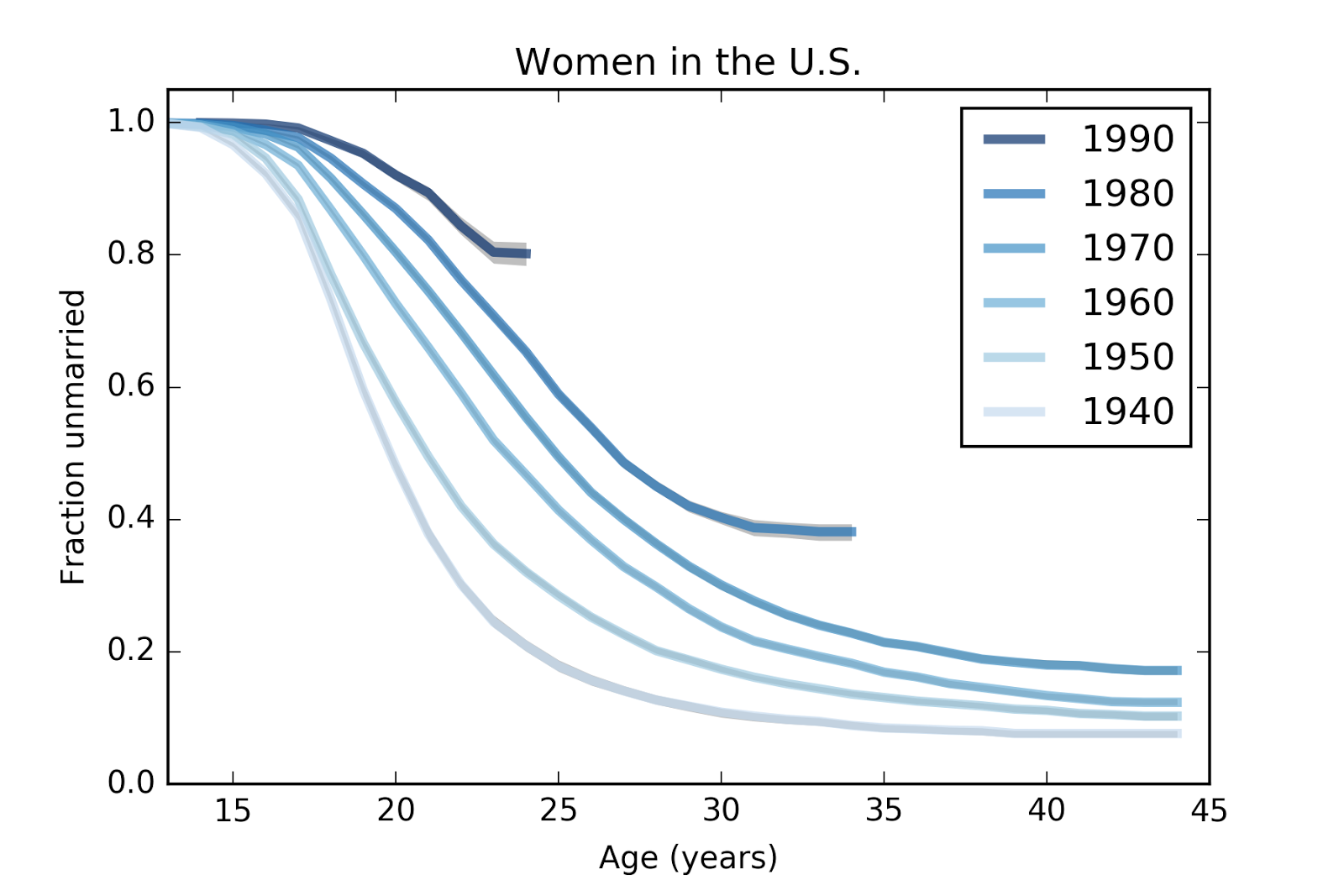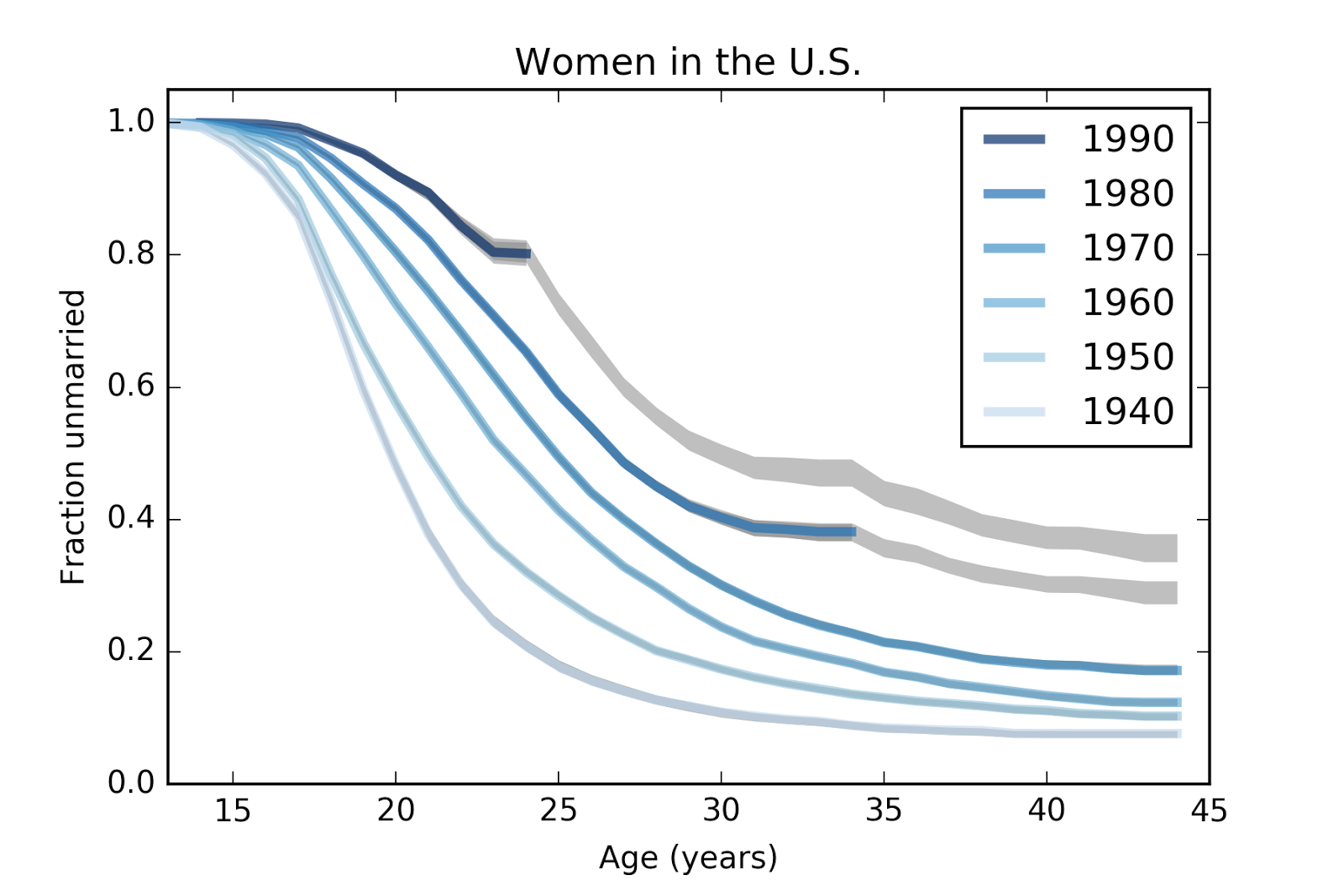https://allendowney.blogspot.com.au/2016/10/millennials-are-still-not-getting.html
Millennials are still not getting married
Last year I presented a paper called "Will Millennials Ever Get Married?" at SciPy 2015. You can see video of the talk and download the paper here.
I used data from the National Survey of Family Growth (NSFG) to estimate the age at first marriage for women in the U.S., broken down by decade of birth. I found evidence that women born in the 1980s and 90s were getting married later than previous cohorts, and I generated projections that suggest they are on track to stay unmarried at substantially higher rates.
Yesterday the National Center for Health Statistics (NCHS) released a new batch of data from surveys conducted in 2013-2015. I downloaded it and updated my analysis. Also, for the first time, I apply the analysis to the data from male respondents.
Women
Based on a sample of 58488 women in the U.S., here are survival curves that estimate the fraction who have never been married for each birth group (women born in the 1940s, 50s, etc) at each age.

For example, the top line represents women born in the 1990s. At age 15, none of them were married; at age 24, 81% of them are still unmarried. (The survey data runs up to 2015, so the oldest respondents in this group were interviewed at age 25, but the last year contains only partial data, so the survival curve is cut off at age 24).
For women born in the 1980s, the curve goes up to age 34, at which point about 39% of them had never been married.
Two patterns are visible in this figure. Women in each successive cohort are getting married later, and a larger fraction are never getting married at all.
By making some simple projections, we can estimate the magnitude of these effects separately. I explain the methodology in the paper. The following figure shows the survival curves from the previous figure as well as projections shown in gray:

These results suggest that women born in the 1980s and 1990s are not just getting married later; they are on pace to stay unmarried at rates substantially higher than previous cohorts. In particular, women born in the 1980s seem to have leveled off; very few of them have been married between ages 30 and 34. For women born in the 1990s, it is too early to tell whether they have started to level off.
The following figure summarizes these results by taking vertical slices through the survival curves at ages 23, 33 and 43.

n this figure the x-axis is birth cohort and the y-axis is the fraction who have never married.
1) The top line shows that the fraction of women never married by age 23 has increased from 25% for women born in the 40s to 81% for women born in the 90s.
2) The fraction of women unmarried at age 33 has increased from 9% for women born in the 40s to 38% for women born in the 80s, and is projected to be 47% for women born in the 90s.
3) The fraction of women unmarried at age 43 has increased from 8% for women born in the 40s to 17% for women born in the 70s, and is projected to be 36% for women born in the 1990s.
These projections are based on simple assumptions, so we should not treat them as precise predictions, but they are not as naive as a simple straight-line extrapolations of past trends.
Millennials are still not getting married
Last year I presented a paper called "Will Millennials Ever Get Married?" at SciPy 2015. You can see video of the talk and download the paper here.
I used data from the National Survey of Family Growth (NSFG) to estimate the age at first marriage for women in the U.S., broken down by decade of birth. I found evidence that women born in the 1980s and 90s were getting married later than previous cohorts, and I generated projections that suggest they are on track to stay unmarried at substantially higher rates.
Yesterday the National Center for Health Statistics (NCHS) released a new batch of data from surveys conducted in 2013-2015. I downloaded it and updated my analysis. Also, for the first time, I apply the analysis to the data from male respondents.
Women
Based on a sample of 58488 women in the U.S., here are survival curves that estimate the fraction who have never been married for each birth group (women born in the 1940s, 50s, etc) at each age.

For example, the top line represents women born in the 1990s. At age 15, none of them were married; at age 24, 81% of them are still unmarried. (The survey data runs up to 2015, so the oldest respondents in this group were interviewed at age 25, but the last year contains only partial data, so the survival curve is cut off at age 24).
For women born in the 1980s, the curve goes up to age 34, at which point about 39% of them had never been married.
Two patterns are visible in this figure. Women in each successive cohort are getting married later, and a larger fraction are never getting married at all.
By making some simple projections, we can estimate the magnitude of these effects separately. I explain the methodology in the paper. The following figure shows the survival curves from the previous figure as well as projections shown in gray:

These results suggest that women born in the 1980s and 1990s are not just getting married later; they are on pace to stay unmarried at rates substantially higher than previous cohorts. In particular, women born in the 1980s seem to have leveled off; very few of them have been married between ages 30 and 34. For women born in the 1990s, it is too early to tell whether they have started to level off.
The following figure summarizes these results by taking vertical slices through the survival curves at ages 23, 33 and 43.

n this figure the x-axis is birth cohort and the y-axis is the fraction who have never married.
1) The top line shows that the fraction of women never married by age 23 has increased from 25% for women born in the 40s to 81% for women born in the 90s.
2) The fraction of women unmarried at age 33 has increased from 9% for women born in the 40s to 38% for women born in the 80s, and is projected to be 47% for women born in the 90s.
3) The fraction of women unmarried at age 43 has increased from 8% for women born in the 40s to 17% for women born in the 70s, and is projected to be 36% for women born in the 1990s.
These projections are based on simple assumptions, so we should not treat them as precise predictions, but they are not as naive as a simple straight-line extrapolations of past trends.
 Not like men want to get married anyways.
Not like men want to get married anyways.

